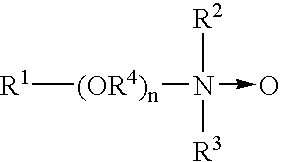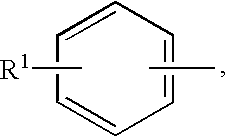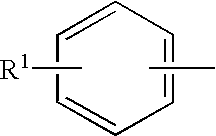Methods for washing poultry during processing with medium chain peroxycarboxylic acid compositions
a technology of peroxycarboxylic acid and composition, which is applied in the direction of milk preservation, detergent compounding agent, liquid cleaning, etc., can solve the problems of significant number of carcasses being cross-contaminated with pathogens, poultry skin contamination is worsened, and the burden of microorganisms cannot be significantly reduced by the procedure, etc., to achieve safe ingestibility by humans, reduce microbial contamination, and high antimicrobial
- Summary
- Abstract
- Description
- Claims
- Application Information
AI Technical Summary
Benefits of technology
Problems solved by technology
Method used
Image
Examples
example 1
Compositions Including Medium Chain Peroxycarboxylic Acid and Solubilizer
[0254] Tables 1-5 present illustrative examples of the present compositions including medium chain peroxycarboxylic acid and solubilizer. Quantities in the tables are in wt-%.
TABLE 1Examples of Compositions Including Solvent SolubilizerIngredientABCDEMedium Chain1.81.61.41.62.9Peroxycarboxylic AcidMedium Chain3.43.63.73.62.4Carboxylic AcidSolubilizer6040606040Carrier2522252222Oxidizing Agent7.06.67.06.96.9Acidulant2252525Stabilizing Agent1.21.21.21.21.2
[0255] In each of compositions A-Q: the medium chain peroxycarboxylic acid was peroxyoctanoic acid; the medium chain carboxylic acid was octanoic acid; the carrier was water; the oxidizing agent was hydrogen peroxide (supplied from a 35% solution); and the stabilizing agent was HEDP (supplied as Dequest 2010 which includes 60 wt-% HEDP).
[0256] In each of compositions A-L, O, P, and Q: the acidulant was concentrated sulfuric acid. In compositions M and N, the ...
example 2
Stability of Compositions Including Medium Chain Peroxycarboxylic Acid and Solubilizer
[0274] Compositions according to the present invention were evaluated and demonstrated physical stability and advantageous stability of the medium chain peroxycarboxylic acid.
Materials and Methods
[0275] Several of the present medium chain peroxycarboxylic acid compositions were evaluated for stability of the medium chain peroxycarboxylic acid. A sealed container including the composition was placed in an oven at an elevated temperature or was left at room temperature for a period of time. The temperatures and times are reported in the tables below. One week at 60° C. can be considered equivalent to a year at room temperature (RT). The quantity of peroxycarboxylic acid was determined by titration.
[0276] Several of the present medium chain peroxycarboxylic acid compositions were also evaluated for physical stability. The sample were visually inspected at intervals at which peroxycarboxylic acid ...
example 3
Shear Thinning Viscosity of Compositions Including Medium Chain Peroxycarboxylic Acid and Solubilizer
[0284] Compositions according to the present invention were evaluated and demonstrated to have advantageous shear thinning viscosity, which is characteristic of microemulsions.
Materials and Methods
[0285] Several of the present medium chain peroxycarboxylic acid compositions were evaluated for viscosity as a function of rate of spindle rotation using an LVT viscometer and an N2 spindle. The temperature of the compositions was room temperature (about 75° F.).
Results
[0286] The results obtained for determinations of viscosity of the present compositions are reported below in Table 7. Decreasing viscosity with increasing spindle rotation rate indicates shear thinning, which is characteristic of a microemulsion. Each of the compositions tested showed shear thinning viscosity.
TABLE 9Shear Thinning Viscosity of Composition LLViscosityViscosityrpm(cp)rpm(cp)0.63875222601.526002.51952...
PUM
 Login to View More
Login to View More Abstract
Description
Claims
Application Information
 Login to View More
Login to View More - R&D
- Intellectual Property
- Life Sciences
- Materials
- Tech Scout
- Unparalleled Data Quality
- Higher Quality Content
- 60% Fewer Hallucinations
Browse by: Latest US Patents, China's latest patents, Technical Efficacy Thesaurus, Application Domain, Technology Topic, Popular Technical Reports.
© 2025 PatSnap. All rights reserved.Legal|Privacy policy|Modern Slavery Act Transparency Statement|Sitemap|About US| Contact US: help@patsnap.com



